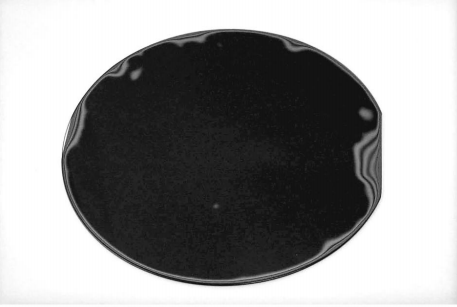We studied cleaning and annealing effects in glass/Si direct bonding using 4 inch Pyrex glass and silicon wafers. SPM cleaning (sulfuric-peroxide mixture, H2SO4 :H2O25 4:1, 120°C! , RCA cleaning ~ NH4OH:H2O2 :H2O5 1:1:5, 80°C! , and combinations of these two methods were examined to investigate the wafer cleaning effect. When wafers were cleaned by RCA after SPM cleaning, maximal bonding quality at room temperature was gained. Surface roughness, as measured by AFM (atomic force microscope), was found to correspond with bonding quality at room temperature. Bonding strength increased as the annealing temperatures increased to 400°C, but debonding occurred at 450°C. The difference in thermal expansion coeffificients of the glass and the Si wafer used led to this debonding. When wafers bonded at room temperature were annealed at 300 or 400°C, the bonding strength increased for 28 hours, and then it decreased with further annealing. The decrease in bonding strength caused by further annealing was due to sodium ion drift through the glass/Si interface.
WDB is commonly used because it opens a wide range of new possibilities for the fabrication and integration of semiconductor devices or micro electro mechanical systems ~ MEMS! devices . WDB provides higher degrees of material integration flflexibility when two dissimilar materials, such as Si/GaAs, Si/glass or InP/Si, are bonded . However, there are two major concerns associated with the WDB of dissimilar materials; thermal mismatch and untoward material interaction between the different wafers during the annealing process. The former requires that the annealing temperature should be kept low in order to prevent debonding during the high temperature annealing processing. The latter depends on the stability of the mating surfaces during heat treatment.
Changes in bonding strength after annealing were investigated using Si and glass wafer pairs cleaned using RCA after SPM. Two sets of annealing were performed under the atmospheric pressure. The fifirst set at constant time ~ 28 hours! for various annealing temperatures ~ 200, 300, 400 and 450°C), and the second set at constant temperature ~ 300 and 400°C) for various annealing times ~ 6, 28, and 50 hours! . Bonding strengths were determined using the crack opening method ; a razor blade was inserted between the two wafers and the crack opening length was measured using a ruler. The ion drift from the glass wafer to the Si was measured by SIMS ~ secondary ion mass spectrometry! depth profifile analysis. Debonded from the glass wafer, the surface of the Si wafer ~ which was the interface between the bonded Si and glass wafers! was SIMS-analyzed.
Figure 1 presents optical images of the bonded wafers at room temperature after various cleaning processes. Because the glass wafer was transparent, the presence of any gap between the two wafers can be identifified by an interference pattern. Interference patterns are widely spread over all the wafers in Figs. 1(a) and (b), which were cleaned by RCA or SPM alone. The best quality room temperature bonding was gained when both glass and silicon wafers were cleaned with RCA after SPM, as shown in Fig. 1(d).
The surface roughness of the glass wafer was correlated with room temperature bonding quality by optical inspection, as shown in Fig. 1. These results imply that there are reactions between cleaning methods. SPM is a strong acid and may leave residues on the surface , whereas RCA is a strong alkali and may attack the wafer surface . Our results suggest that when RCA is used after SPM, the RCA solution neutralizes the residue from the previous cleaning step. Therefore, the increase of the surface roughness during cleaning process may be reduced by the interaction between the residue and the solution. Furthermore, the fifinal RCA cleaning may have left the OH2 radical on the surface, which can enhance hydrogen bonding. Probably, due to these effects, RCA after SPM cleaning maximized surface bonding and cleaning.
The effects of wafer cleaning and heat treatment on the direct bonding of glass and Si wafers were investigated. When wafers were cleaned by RCA after SPM treatment, room temperature bonding quality was maximized, due to a minimal surface roughness. Bonding strength was found to be sensitive to temperature and time during annealing. The different thermal expansion coeffificients of glass and Si wafer led to debonding at 450°C. When wafers were annealed at constant temperature, the bonding strength increased over 28 hours, but then decreased. This decreased bonding strength after further annealing was attributed to the drift of sodium ions through the glass/Si interface. Our results imply that maximum bonding strength can be achieved by optimizing the cleaning and annealing processes. Practically, debonding can be also controlled by using the annealing conditions.

Fig1(d)
Figure 4 shows the variation of bonding strength during annealing at 300 and 400°C. Bonding strength increased with time up to 28 hours. The rate of increase of stress is higher at an annealing temperature of 400°C than that of 300°C. However, after annealing for 50 hours the strength decreased. The increase in bonding strength with annealing time can be explained by increased degree of covalent bonds. This rate should be faster at higher temperature. However, decreased bonding strength upon further annealing means that there is a mechanism, which destroys bonding. We suggest that this could be due to the ion drift during further annealing.
下一篇: 兆声波技术进行TSV蚀刻后清洗工艺